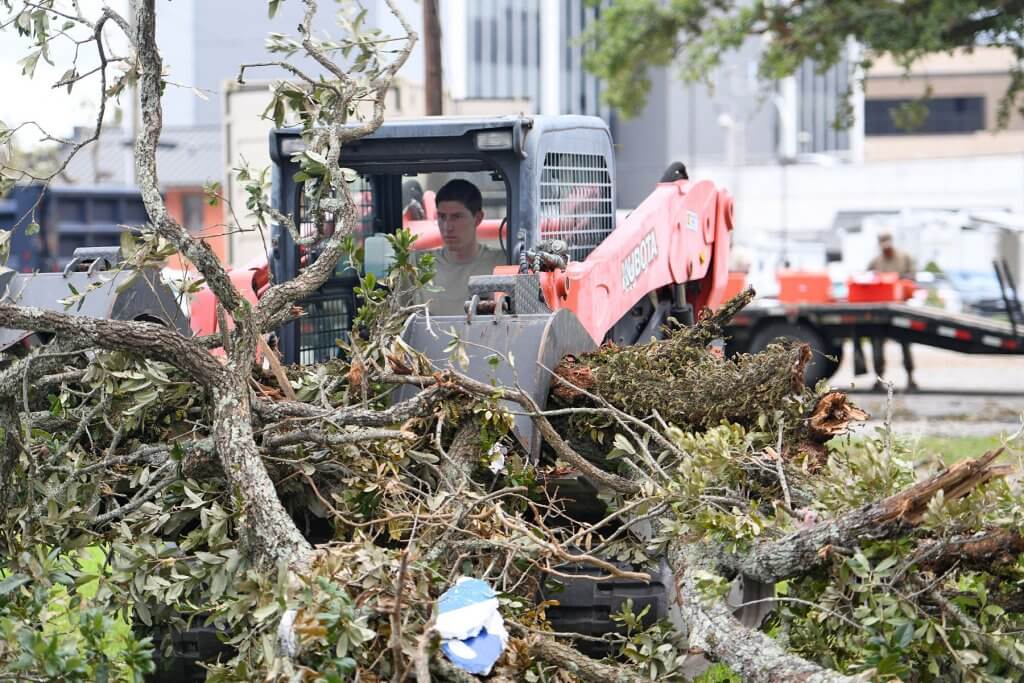When Hurricane Laura blew ashore early on Aug. 27 near Cameron, Louisiana, it did not bring the amount of storm surge that so many feared.
The level of devastation, unfortunately, arrived as forecast.
It is still being felt throughout parts of Louisiana and Texas, more than a week after Laura made landfall as a Category 4 storm and as a new storm approaches.
“It was like a 100-mile tornado passed through there,’’ Louisiana National Guard Sgt. 1st Class Denis Ricou said via phone of the area around Lake Charles — about 50 miles north of Cameron. “When I walked through there, there wasn’t a house, business, fence, telephone pole [or] billboard that wasn’t affected by the storm. For miles and miles, it was just destruction and damage.’’
As of last week, nearly 6,100 Louisiana National Guard members have been deployed in the recovery and cleanup effort, including about 500 committed to COVID-19 testing and food banks, Ricou said. The Guard has delivered more than 3.6 million liters of water, more than 2.4 million MREs, 348,000 bags of ice and 114,000 tarps to 40 sites in 17 parishes, he said. The Louisiana National Guard also is providing potable water in 2,000-gallon tanks, known as Hippos, at some locations.
About 2,158 miles of road have been assessed, and debris has been cleared off 1,672 miles of road, Ricou said.
The Texas State Guard deployed more than a thousand members to 12 distribution sites, four shelters in Dallas and “emergency tracking network teams’’ in five cities, Staff Sgt. Gregory Illich said in an email.
“[We conducted] swift-water rescue operations with both high-water vehicles and air assets …,’’ Illich said. “Also, the 6th civil support team from Austin deployed to assist the Texas Commission on Environmental Quality and perform air-quality testing to detect the presence of hazardous materials, toxic industrial products, that could be released from chemical plants due to damage sustained in a storm such as Hurricane Laura.’’
As of Wednesday, the Texas State Guard has handed out 250,000 bottles of water, nearly 150,000 MREs and about 25,500 bags of ice, Illich said.
Nineteen deaths are blamed so far on Laura in Louisiana, while five people died because of the storm in Texas. The economic and property losses reportedly are estimated as much as $20 billion for one of the worst storms ever to strike the Gulf Coast.
“There’s still many roads that are just impassable,’’ Ricou said. “I couldn’t get on the interstate [Wednesday], leaving one of our sites.’’
Royal Barnes, a senior airman, is part of the Louisiana Air National Guard’s civil engineering squadron.
“It kind of looks like Katrina because people have trees in front of their houses … or they have trees on top of their houses,” Barnes said in a news release.
Katrina made landfall on the Louisiana coast in 2005 and killed about a thousand people in the state, according to the National Hurricane Center.
Now, Guard members in Louisiana and Texas are dealing not only with what Laura left behind but also their continuing mission regarding the coronavirus pandemic.
“We are prepared for disaster response in a COVID-19 environment,’’ Illich said. “The Texas Military Department is working closely with the Texas Division of Emergency Management to ensure our forces have the personal protective equipment needed to conduct missions safely. We have strategically placed PPE throughout the state and have supplies ready to be moved where needed.’’
Meanwhile in Louisiana, the Guard has witnessed firsthand the struggle that some residents are enduring.
“Citizens sleeping in tents, trying to get RVs just to park by their house, just to have somewhere safe to sleep with some sort of air conditioning …,’’ Ricou said. “Each morning, they wake up and start cleaning and start trying to rebuild.’’

